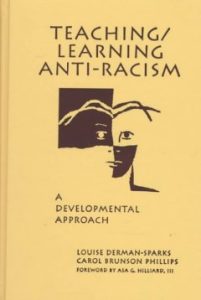
Teaching/Learning Anti-Racism: A Developmental Approach
Authors: Louise Derman-Sparks and Carol Brunson Phillips
Drawing on experience teaching a college course, this book explains the process that evolves as teachers and students grapple with learning about racism and becoming antiracist. Racism is defined as an institutionalized system of economic, political, social, and procedural relations that ensures that one racial group has and maintains power and privilege over all others. Individuals participate in racism when an objective outcome of behavior reinforces these relations, regardless of their intention. Consequently, an individual may act in a racist manner unintentionally. Antiracism education is the beginning of a new approach to thinking, feeling, and acting. Part I of this book describes the conceptual framework for antiracism and the premises underlying the researchers’ pedagogy. Part II describes the course “Racism and Human Development,” and details how each class session contributes to the progression of students’ growth. Each chapter in this section focuses on a major developmental phase of student growth, and within each chapter teaching challenges, activities and teaching strategies, and analyses of student growth are discussed. Part III discusses ways teachers can personalize the course for their own classes. Topics include (1) reflections on generic issues related to antiracist education; (2) factors to consider when adapting the course to different settings, students, and social-political dynamics; and (3) suggestions for continuing self-education.
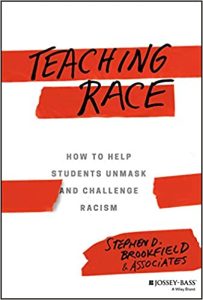
Teaching Race: How to Help Students Unmask and Challenge Racism
Author: Stephen D. Brookfield and Associates
In Teaching Race the authors offer practical tools and techniques for teaching and discussing racial issues at predominately White institutions of higher education. As current events highlight the dynamics surrounding race and racism on campus and the world beyond, this book provides teachers with essential training to facilitate productive discussion and raise racial awareness in the classroom. A variety of teaching and learning experts provide insights, tips, and guidance on running classroom discussions on race. They present effective approaches and activities to bring reluctant students into consideration of race and explore how White teachers can model racial awareness, thereby inviting students into the process of examining their own white identity. Racism, whether evident in overt displays or subconscious bias, has repercussions that reverberate far beyond the campus grounds. As the cultural climate increasingly calls out for more research, education, and dialogue on race and racism, this book helps teachers spotlight issues related to race in a way that leads to effective classroom and campus conversation.
The book provides guidance on how to:
• Create the conditions that facilitate respectful racial dialogue by building trust and effectively negotiating conflict.
• Uncover each student’s own subconscious bias and the intersectionality that exists even in the most homogenous-appearing classrooms.
• Help students embrace discomfort and adapt discussion methods to accommodate issues of race and positionality.
• Avoid common traps, mistakes, and misconceptions encountered in anti-racist teaching.
Predominantly White institutions face a number of challenges in dealing with race issues, including a lack of precedence, an absence of modeling by campus leaders, and little clear guidance on how teachers can identify and challenge racism on campus. Teaching Race is packed with activities, suggestions, and exercises to provide practical real-world help for teachers trying to introduce race in class.
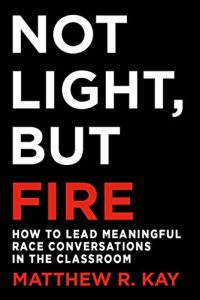
Not Light, but Fire: How to Lead Meaningful Race Conversations in the Classroom
Author: Matthew R. Kay
Do you feel prepared to initiate and facilitate meaningful, productive dialogues about race in your classroom? Are you looking for practical strategies to engage with your students? Inspired by Frederick Douglass’s abolitionist call to action, “it is not light that is needed, but fire.” Matthew Kay has spent his career learning how to lead students through the most difficult race conversations. Kay not only makes the case that high school classrooms are one of the best places to have those conversations, but he also offers a method for getting them right, providing candid guidance on: How to recognize the difference between meaningful and inconsequential race conversations. How to build conversational “safe spaces,” not merely declare them. How to infuse race conversations with urgency and purpose. How to thrive in the face of unexpected challenges. How administrators might equip teachers to thoughtfully engage in these conversations. With the right blend of reflection and humility, Kay asserts, teachers can make school one of the best venues for young people to discuss race.
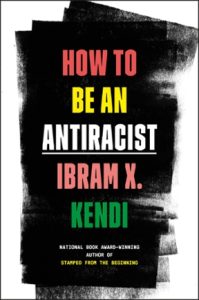
Author: Ibram X. Kendi
“The only way to undo racism is to consistently identify and describe it — and then dismantle it.” Ibram X. Kendi’s concept of antiracism reenergizes and reshapes the conversation about racial justice in America — but even more fundamentally, points us toward liberating new ways of thinking about ourselves and each other. In How to Be an Antiracist, Kendi asks us to think about what an antiracist society might look like, and how we can play an active role in building it. In this book, Kendi weaves an electrifying combination of ethics, history, law, and science, bringing it all together with an engaging personal narrative of his own awakening to antiracism. How to Be an Antiracist is an essential work for anyone who wants to go beyond an awareness of racism to the next step: contributing to the formation of a truly just and equitable society.”– Provided by publisher.
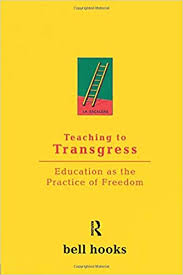
Teaching to Transgress: Education as the Practice of Freedom
Author: Bell Hooks
In this book, the author shares her philosophy of the classroom, offering ideas about teaching that fundamentally rethink democratic participation. She writes about a new kind of education, education as the practice of freedom. She advocates the process of teaching students to think critically and raises many concerns central to the field of critical pedagogy, linking them to feminist thought. In the process, these essays face squarely the problems of teachers who do not want to teach, of students who do not want to learn, of racism and sexism in the classroom. Teaching students to “transgress” against racial, sexual, and class boundaries in order to achieve the gift of freedom is, for the author, the teacher’s most important goal.
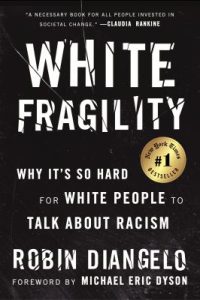
White Fragility: Why It’s So Hard for White People to Talk about Racism
Author: Robin DiAngelo
Antiracist educator Robin DiAngelo illuminates the phenomenon of white fragility and “allows us to understand racism as a practice not restricted to ‘bad people’ (Claudia Rankine). Referring to the defensive moves that white people make when challenged racially, white fragility is characterized by emotions such as anger, fear, and guilt, and by behaviors including argumentation and silence. These behaviors, in turn, function to reinstate white racial equilibrium and prevent any meaningful cross-racial dialogue. In this in-depth exploration, DiAngelo examines how white fragility develops, how it protects racial inequality, and what we can do to engage more constructively.
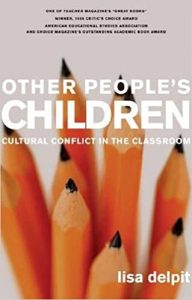
Other People’s Children: Cultural Conflict in the Classroom
Author: Lisa Delpit
In a radical analysis of contemporary classrooms, MacArthur Award-winning author Lisa Delpit develops ideas about ways teachers can be better “cultural transmitters” in the classroom, where prejudice, stereotypes, and cultural assumptions breed ineffective education. Delpit suggests that many academic problems attributed to children of color are actually the result of miscommunication, as primarily white teachers and “other people’s children” struggle with the imbalance of power and the dynamics plaguing our system.
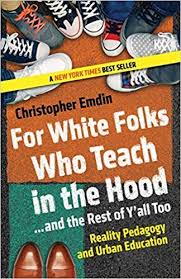
Author: Christopher Emdin
“Merging real stories with theory, research, and practice, a prominent scholar offers a new approach to teaching and learning for every stakeholder in urban education. Drawing on his own experience of feeling undervalued and invisible in science classrooms as a young man of color, Christopher Emdin offers a new lens on and approach to teaching in urban schools. Putting forth his theory of Reality Pedagogy, Emdin provides practical tools to unleash the brilliance and eagerness of youth and educators alike–both of whom have been typecast and stymied by outdated modes of thinking about urban education. With this fresh and engaging new pedagogical vision, Emdin demonstrates the importance of creating a family structure and building communities within the classroom, using culturally relevant strategies like hip-hop music and call-and-response, and connecting the experiences of urban youth to indigenous populations globally”– Provided by publisher.
Click on the heading “Articles” to access the literature listed below
Denis, V. S., & Schick, C. (2003). What makes anti-racist pedagogy in teacher education difficult? Three popular ideological assumptions. Alberta Journal of Educational Research, 49(1).
This article arises from the teaching observations and struggles of two anti-racist educators who co-developed and taught a required cross-cultural education course for predominantly white-identified preservice teachers in a Canadian prairie context. The article identifies three common ideological assumptions about the production of inequality frequently held by these students: race does not matter; everyone has equal opportunity; and through individual acts and good intentions one can secure innocence as well as superiority. These preservice teachers are required to examine the dominant identifications and power relations through which they are produced and unwittingly implicated in reproducing the status quo.
Florian, L., & Black‐Hawkins, K. (2011). Exploring inclusive pedagogy. British Educational Research Journal, 37(5), 813-828.
This paper reports on a study designed to examine teachers’ craft knowledge of their practice of ‘inclusion’ in terms of what they do, why, and how. The research approach offers an important alternative to studies of students with ‘additional needs’ and the search to articulate the specialist knowledge and skill required to teach them. Through classroom observations and interviews with 11 teachers of students across the full age range in two Scottish primary schools, we investigated how teachers make meaning of the concept of inclusion in their practice by exploring theoretical as-sumptions drawn from the literature about inclusive pedagogy. The analysis enabled us to identify practical examples of inclusive pedagogy that met the standard of extending what is generally available to everybody, as opposed to providing for all by differentiating for some. Examples of the inclusive pedagogical approach are provided.
Kishimoto, K. (2018). Anti-racist Pedagogy: From faculty’s self-reflection to organizing within and beyond the classroom. Race Ethnicity and Education, 21(4), 540-554.
This article is a synthesis of my own work as well as a critical reading of the key literature in anti-racist pedagogy. Its purpose is to define anti-racist pedagogy and what applying this to courses and the fullness of our professional lives entails. I argue that faculty need to be aware of their social position, but more importantly, to begin and continue critical self-reflection in order to effectively implement anti-racist pedagogy, which has three components: (1) incorporating the topics of race and inequality into course content, (2) teaching from an anti-racist pedagogical approach, and (3) anti-racist organizing within the campus and linking our efforts to the surrounding community. In other words, anti-racist pedagogy is an organizing effort for institutional and social change that is much broader than teaching in the classroom.
Blakeney, A. M. (2005). Antiracist pedagogy: Definition, theory, and professional development. Journal of Curriculum and Pedagogy, 2(1), 119-132.
The purpose of this paper is to define Antiracist Pedagogy and establish it within the sociological framework of Critical Theory. Antiracist Pedagogy is a paradigm located within Critical Theory utilized to explain and counteract the persistence and impact of racism. This paper indicates the need for the establishment of Antiracist Pedagogy within the school curriculum as well as the necessary professional development required to implement Antiracist Pedagogy effectively.
Hassouneh, D. (2006). Anti-racist Pedagogy: Challenges faced by faculty of color in predominantly white schools of nursing. Journal of Nursing Education, 45(7), 255-262.
Despite the significant effects of systems of oppression on health, nursing education tends not to include anti-racist pedagogy in its curricula, preferring instead to focus more narrowly on culture. This narrow focus allows nurs-es to depoliticize discussions of race and other social differences, largely ignoring the influence that systems of oppression, imperialism, and historical trauma have had on health in marginalized populations. In contrast, anti-racist pedagogy educates students in ways that make racialized power relations explicit, deconstruct the social construction of race, and analyze interlocking systems of oppression that serve to marginalize and exclude some groups while privileging others. This article describes anti-racist pedagogy from the perspective of a faculty member of color, drawing on personal experience and a review of the anti-racist pedagogical literature. Specifically, this article highlights some of the personal and professional challenges faced by faculty of color when engaged in anti-racist pedagogy in predominantly white schools of nursing.
Niemonen, J. (2007). Antiracist education in theory and practice: A critical assessment. The American Sociologist, 38(2), 159-177.
“Antiracist Education in Theory and Practice: A Critical Assessment” As a set of pedagogical, curricular, and organizational strategies, antiracist education claims to be the most progressive way today to understand race relations. Constructed from whiteness studies and the critique of colorblindness, its foundational core is located in approximately 160 papers published in peer-reviewed journals in the past 15 years-identified through a comprehensive search of AcademicPremier Search, EBSCOMegaFile, Education Abstracts, JSTOR, andSOCIndex. A critical assessment of these papers concludes that antiracist education is not a sociologically grounded, empirically-based account of the significance of race in American society. Rather, it is a morally based educational reform movement that embodies the confessional and redemptive modes common in evangelical Protestantism. Inherently problematic, whether or not antiracist education achieves broader acceptance is open to debate.
López, N. (2008). Antiracist pedagogy and empowerment in a bilingual classroom in the US, circa 2006. Theory Into Practice, 47(1), 43-50.
How can teachers and administrators improve the educational environment for Latino/as and other racially stigmatized youth? What does antiracist pedagogy for Latino/a immigrant youth look like? This article describes the thought, action, and reflection employed by a bilingual 9th-grade teacher in the Southwest. Antiracist pedagogical strategies include creating an empowering classroom physical space, articulating an antiracist discourse, and encouraging students to resist oppression through civic participation and activism. The author argues that antiracist pedagogy that is anchored in empowering Latino/a immigrant youth is a key part of creating welcoming school spaces that nurture the resilience of Latino/a youth and their families.
Blackwell, D. M. (2010). Sidelines and separate spaces: Making education anti‐racist for students of color. Race Ethnicity and Education, 13(4), 473-494.
The way in which anti‐racist education is currently conceptualized and practiced holds very few benefits for students of color. By using whiteness theory and the politics of identity and difference, many educators have developed pedagogical interventions that are concerned with bringing white students into a consciousness about racism and white privilege, and examining the effect of racial identity politics on classroom interactions. Their aim to cultivate an anti‐oppressive educational environment for all students is undermined by their preoccupation with identity politics, whiteness and white students. Thus, in both theory and practice, students of color are often rendered invisible on the sidelines or their personal stories are used to benefit white students and white educators. Scholar‐practitioners in this field have not adequately considered what counts as anti‐racist education for students of color. In this paper, I tell stories about my own experiences as a black woman graduate student as a way of ‘talking back’ to the disjunctures between pedagogical intentions and the disappointing realities of anti‐racist classrooms. I identify the pedagogical obstacles that block instructors from positioning students of color as a central educational concern alongside their white classmates, and argue that anti‐racist educators must reexamine their principles and practices from the standpoint of students of color. Finally, I turn to black feminist standpoint theory to discuss the importance of racially separate spaces as a pedagogical intervention that can make education anti‐racist for students of color.
Jones, C. P. (2000). Levels of racism: A theoretic framework and a gardener’s tale. American journal of public health, 90(8), 1212.
The author presents a theoretic framework for understanding racism on3 levels: institutionalized, personally mediated, and internalized. This framework is useful for raising new hypotheses about the basis of race-associated differences in health outcomes, as well as for designing effective interventions to eliminate those differences. She then presents an allegory about a gardener with 2 flower boxes, rich and poor soil, and red and pink flowers. This allegory illustrates the relationship between the 3 levels of racism and may guide our thinking about how to intervene to mitigate the impacts of racism on health. It may also serve as a tool for starting a national conversation on racism.
Carol Schick (2000) ‘By Virtue of Being White’: Resistance in anti-racist pedagogy. Race Ethnicity and Education, 3(1), 83-101.
This research, which employs post-structuralist and psychoanalytic theories of identity, investigates processes by which white, racialised identities are inscribed as normative constructions in the discourses of white pre-service teachers at a Canadian university. Semi-structured interviews were conducted with white students whose desires for respectability and legitimacy are at odds with the imminent critique of anti-racist pedagogy. The analysis indicates processes by which research participants are able to profess liberal values and innocence from racist acts while accessing discursive repertoires which perform them as racially dominant. The power of dominant groups to resist oppositional pedagogies problematises the potential for whiteness to affirm itself, even as a virtue, in sites of liberal teacher education. The article questions how white pre-service teachers’ desires for goodness might be thought in ways which support instability and flux, notwithstanding students’ desires for secure identities.
Melissa Mosley (2010) ‘That really hit me hard’: Moving beyond passive anti‐racism to engage with critical race literacy pedagogy. Race Ethnicity and Education, 13(4), 449-471.
This study interrogates how understandings about racism and anti-racism are constructed through interactions with students as well as peers in preservice teacher education contexts towards a closer understanding of racial literacy as both a personal and pedagogical tool. Critical race literacy pedagogy – a subset of the approaches known as multicultural education, culturally responsive teaching, and anti-racist teaching – is a set of tools to practice racial literacy in school settings with children, peers, colleagues, and so forth. In this article, I explore the construction of critical race literacy pedagogy for one white preservice teacher in a U.S. teacher education program through two engagements with literacy pedagogy: a reading lesson with two African American students and the discussion of a children’s literature text in a teacher education book club. Through the critical, mediated discourse analysis of these two engagements, we see that for
Kelly, the process of enacting racial literacy in a reading lesson required anti-racist discourse patterns not yet available to her; whereas in the book club, interviews, and written reflections she was able to articulate what it means to practice racial literacy, pinpoint the breakdown of her pedagogy, and develop what it means to be ‘actively’ anti-racist as a literacy teacher. The findings of this study suggest the complexity of the roles and the variety of paths available for white teachers who desire to be anti-racist teachers. Ultimately, the findings indicate that we do not need only to prepare teachers for identities that ‘transcend’ predictable ways of being white but to construct a more complete framework for what it means to practice racial literacy in educational contexts.
Akamine Phillips, J., Risdon, N., Lamsma, M., Hambrick, A., & Jun, A. (2019). Barriers and strategies by white faculty who incorporate anti-racist pedagogy. Race and Pedagogy Journal: Teaching and Learning for Justice, 3(2), 1.
This study focused on the experiences of White faculty who incorporate an anti-racist framework into their college classrooms. The participants shared about the challenges of incorporating anti-racist pedagogy into their classrooms due to both perceived personal and institutional barriers. These participants perceived personal barriers stemming from an internalized struggle of understanding their own White identity while also struggling to be viewed as anti-racist educators by colleagues of color. These faculty participants also shared about perceived professional barriers which included the pressure to obtain tenure, perceived loss of control in the classroom by the students, and anti-racist work being disregarded by individuals in positions of institutional power. Through the use of narrative inquiry, five researchers explored the personal and professional barriers faced by White faculty engaging in anti-racist educational practices in the college classroom. The study included17 faculty participants teaching at predominately White private and public colleges and universities throughout the United States who teach in various academic disciplines. Findings revealed the ongoing barriers in teaching anti-racism ideals and the discussion provides strategies and an emerging model for incorporating intentional anti-racist pedagogy into the classroom.
Husband Jr, T. (2010). He’s Too Young to Learn About That Stuff: Anti-Racist Pedagogy and Early Childhood Social Studies. Social Studies Research & Practice (Board of Trustees of the University of Alabama), 5(2).
Few early childhood teachers engage in critical and anti-racist forms of pedagogical practice, primarily on the basis of developmental and political concerns. With the exception of a few studies, little has been documented relative to early childhood teachers’ experiences while enacting this form of pedagogical practice. The purpose of this article is to examine my teaching experiences engaging in critical, anti-racist pedagogy through the development and implementation of a critical action research study/unit on African American history. Data from this study reveal four levels of challenges that emerged throughout the development and implementation phases of this study/unit. Finally, I discuss several implications of this study for early childhood multicultural practice.
Giroux, H. A. (2003). Spectacles of race and pedagogies of denial: Anti-black racist pedagogy under the reign of neoliberalism. Communication Education, 52(3-4), 191-211.
Quality education in the United States has been compromised via public discourses that reinstitute racism on a daily basis. In its current manifestation, racism survives through the guise of neoliberalism, a kind of repartee that imagines human agency as simply a matter of individualized choices, the only obstacle to effective citizenship and agency being the lack of principled self-help and moral responsibility. In this article, I examine briefly the changing nature of the new racism by analyzing how some of its central assumptions evade notions of race, racial justice, equity, and democracy altogether. My analysis focuses especially on the discourse of color blindness and neoliberal racism. I then address how the racism of denial and neoliberal racism were recently on prominent display in the controversies surrounding former Senate Majority Leader Trent Lott’s praise for segregationist Strom Thurmond. The essay concludes by offering some suggestions about how the new racism, particularly its neoliberal version, can be addressed as both a pedagogical and a political issue.
Kernahan, C., & Chick, N. L. (2017). How do you listen to your students to help them learn about race and racism?. New Directions for Teaching and Learning, 2017(151), 17-30.
Teaching and learning can be especially difficult when the content includes race. We argue here that an effective approach is one that includes multiple angles, learning from our students and from a broad range of colleagues and disciplines.
Tanner, K. D. (2013). Structure matters: Twenty-one teaching strategies to promote student engagement and cultivate classroom equity. CBE—Life Sciences Education, 12(3), 322-331.
A host of simple teaching strategies—referred to as “equitable teaching strategies” and rooted in research on learning—can support biology instructors in striving for classroom equity and in teaching all their students, not just those who are already engaged, already participating, and perhaps already know the biology being taught.
Wagner, A. E. (2005). Unsettling the academy: Working through the challenges of anti‐racist pedagogy. Race Ethnicity and Education, 8(3), 261-275.
Teaching antiracism is a political project, which will be especially challenging in a university environment which has traditionally valued ‘objective’ and ‘apolitical’ knowledge. This analysis focuses on specific pedagogical practices which promote an antiracism framework, with specific attention directed to the process of learning antiracism and how these goals may be furthered within the academy. Exploring some of the inherent challenges and benefits associated with dominant group members assuming responsibility for antiracist teaching, the focus of the paper will also be to examine specific pedagogical practices which may be helpful in introducing students to such emotionally powerful material. The efficacy of such practices will then be explored as a means of challenging the status quo and envisioning a less Eurocentric approach to higher education.
Additionally, explore these links for more “Teaching about Race and Racism” and “Pedagogies of Care” resources.